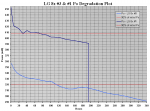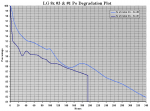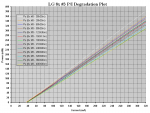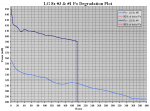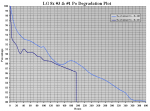IgorT
0
- Joined
- Oct 24, 2007
- Messages
- 4,177
- Points
- 0
If you want to test at the same power as the 1st 8X diode,
that would be 260ma (from graph) x 150% or 390ma.
For the 1st long 12X test procedure, it probably should not be an extreme overdrive.
I believe we should go by power, not current - if we try to calculate how far to push the 12x in relation to one or the other 8x diode...
The first 8x diode was pushed to 2.848x and the second one to 3.624x their rated CW power.
For a 12x, that would be 427.2mW or 543.6mW, regardles of what current would be required to reach it..
If 12x's have the same toughnes as 8x's only at a higher power, that would mean they could survive 427mW for over 340 hours and 544mW for around 200 hours (+/- ?).
After observing the degradation of three 8x diodes, i am becoming convinced, that the determining factor for diode life is the power setting and not the current required to reach it.
On the right side of the attachment below, you can see the murder of multiple diodes, which each required a different current to reach 320mW Pulsed, due to their varying efficiency. And yet the lines are pretty much parallel, indicating that regardless of the current required, the diodes degrade at almost the same rate when set to the same power...
The 60mW Sanyo diode lifetime/degradation chart indicated the same thing as well..
This is a graph from Nichia on 320mw 12X BR diodes:

P.S. Nichia did their life test 30 second intervals at 320mw power for 1000 hours.
Almost comparable to your first test procedure of over 320 hours, when you add the 80° C temp factor.
I am fairly certain, that the 30s in the above attachment is a typo.
They are talking about pulse oscillation with a 50% duty cycle, where the pulsewidth is specified as 30ns in almost every datasheet i've seen.
Also, 1000h is one of their standards of reliability for disk writer drives (the minimum). I don't think the diode could have survived as long with 30 second CW cycles (30s is not really a pulse)...
If it's not a typo, then that's one tough diode, altho why would they test them using their estimated diode working temperature inside a drive (80°C), if the test was completelly unrelated to this application?
It doesn't make sense, it must be a typo. I'm so used to reading 50% duty cycle / 30ns pulse-width, that i when i first read it, i read nanoseconds and not seconds.
Last edited:




